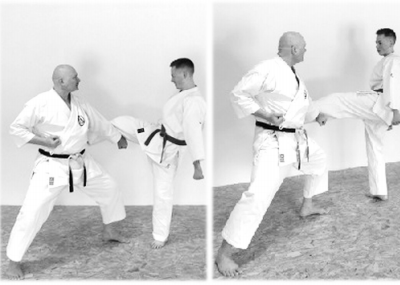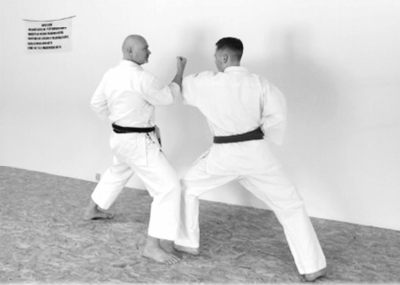Kiai, Kake-goe and Kime, Part 1, Kiai
Kiai and Kime have a certain kind of mystery in Karate and have been highlighted as something supernatural. Kime and Kiai were often associative with power, focus, and of course …
Read more実戦空手

Kiai and Kime have a certain kind of mystery in Karate and have been highlighted as something supernatural. Kime and Kiai were often associative with power, focus, and of course …
Read more
Rules about the Embusen (Line of movement). First, we need to define the term “Kiten”. Wikipedia says: .. “Nearly all Japanese-influenced Kata start and end on exactly the same Embusen …
Read more
This article is about an alternative approach to the basic block Shuto-uke. The well-known basic use of Shuto-uke. My interpretation: Shuto-uke Shuto-uke can be used just like Uchi-uke or Gedan-barai, …
Read more
This article is about an alternative approach to the basic block Gedan-barai. The well-known basic use of Gedan-barai. Everybody knows that one, so no further comments unless you have some! …
Read more
This article is about an alternative approach to the basic block Uchi-uke. The well-known basic use of Uchi-uke. Everybody knows that one. My interpretation: Uchi-uke Uchi-uke can be used as …
Read more
This article is about an alternative approach to the basic block Soto-uke. The well-known basic use of Soto-uke. Everybody knows that one, so no further comments. My interpretation: Soto-uke Soto-uke …
Read more
In this article and the upcoming five articles, I will show some alternative approaches to basic blocking techniques. Here I will show you how I interpret basic blocks, and how …
Read more
The invisible bond – The way of life! In Japan, they have a concept called Giri (duty, sense of duty, honor, decency, courtesy) Giri is an invisible thread, a bond …
Read more
After practicing Karate for many years, it becomes a part of one’s life. Thus, Karate is no longer a physical sports discipline, as it was at the beginning. Karate becomes …
Read more
Now and then, I get this question from a student: “Which part of the foot should we use as a pivoting point when we turn? Should we pivot on the …
Read more